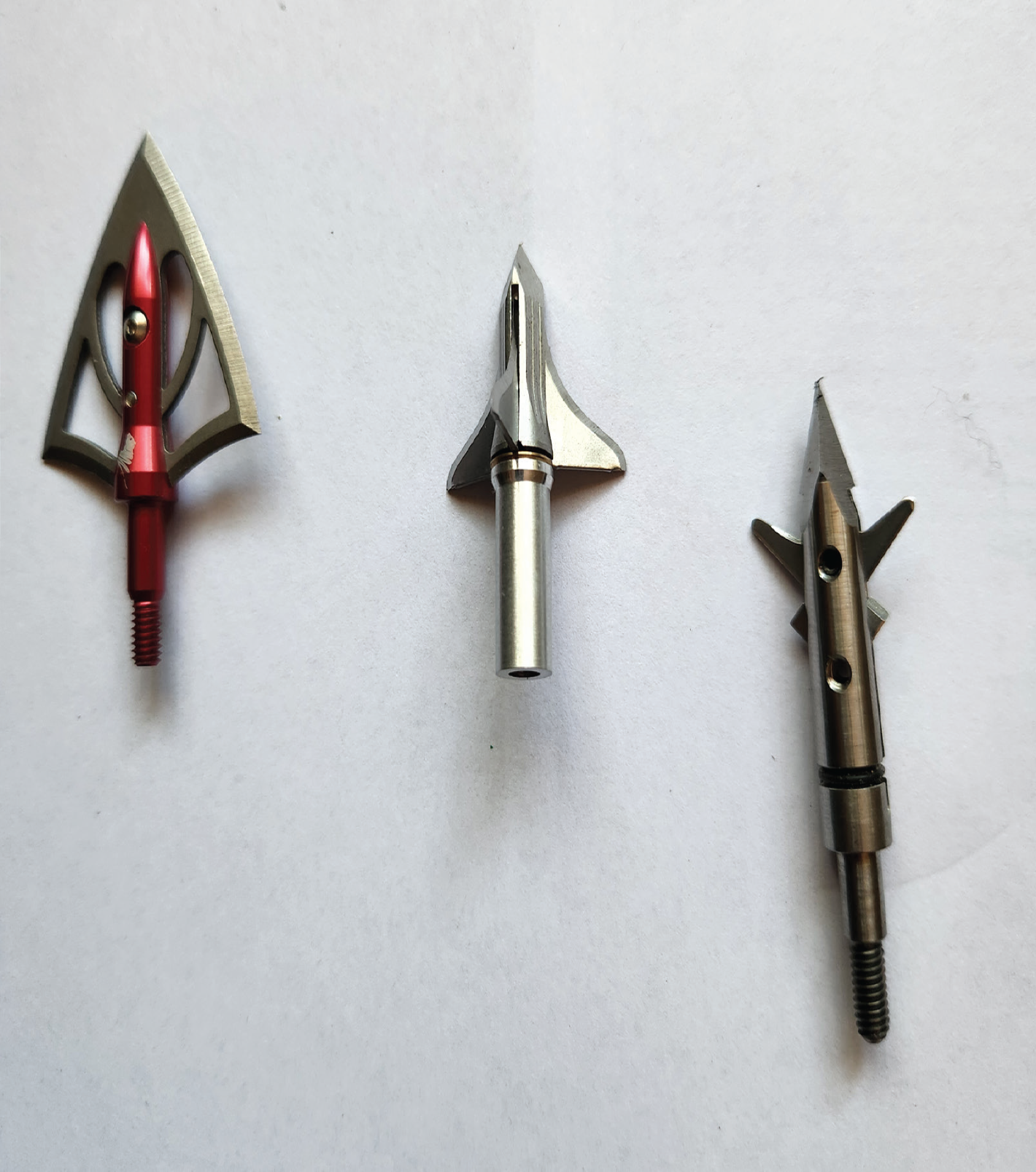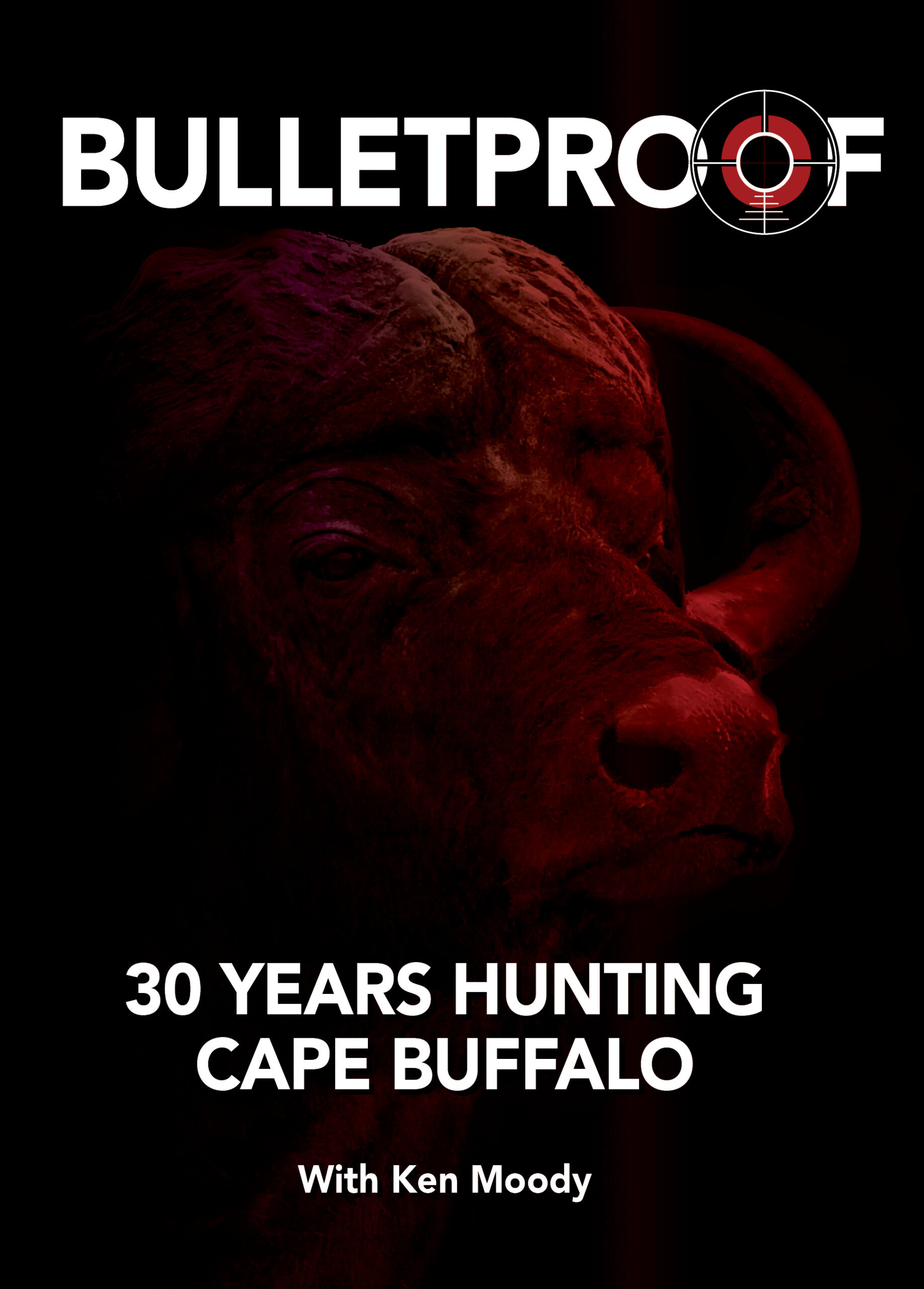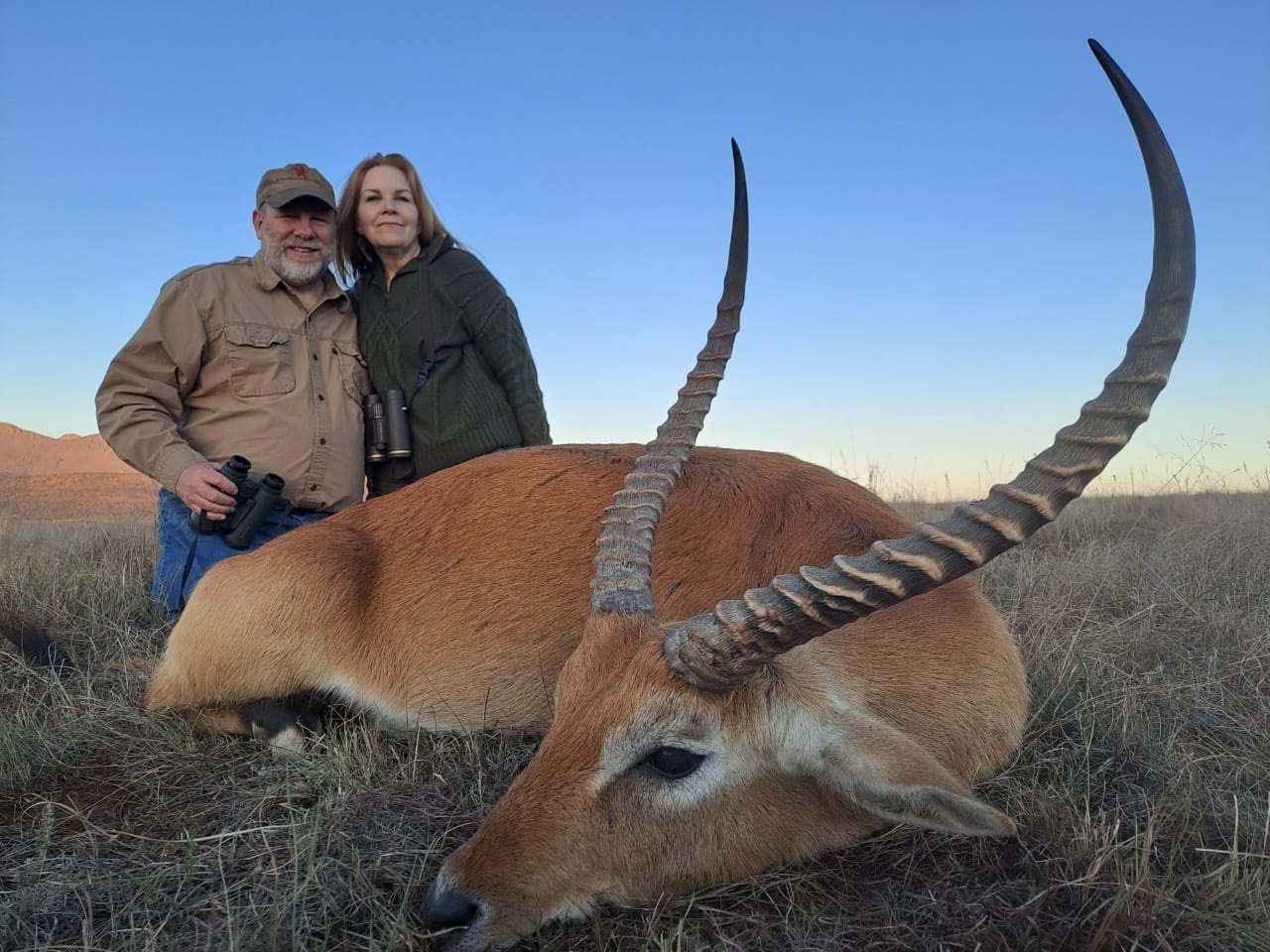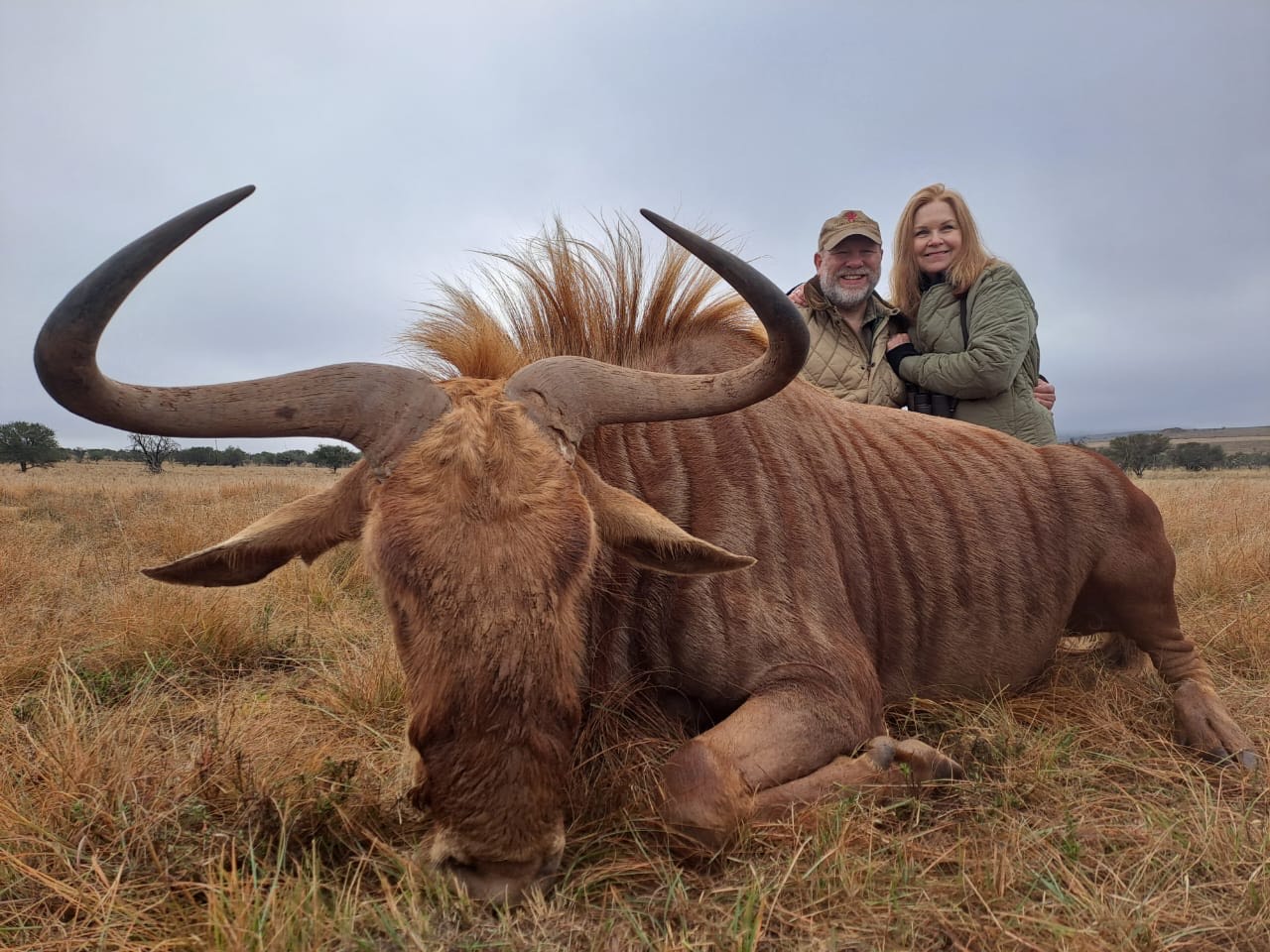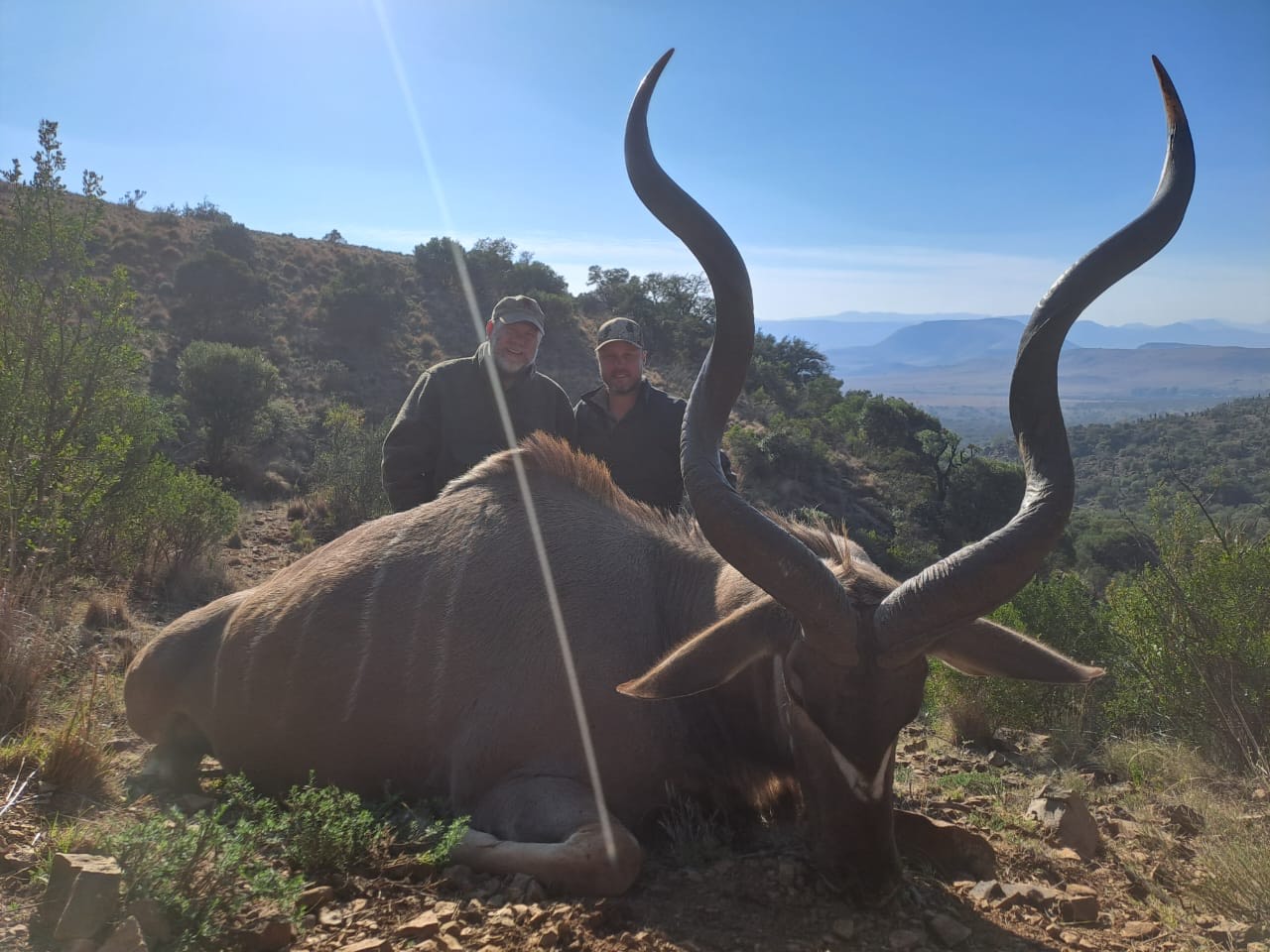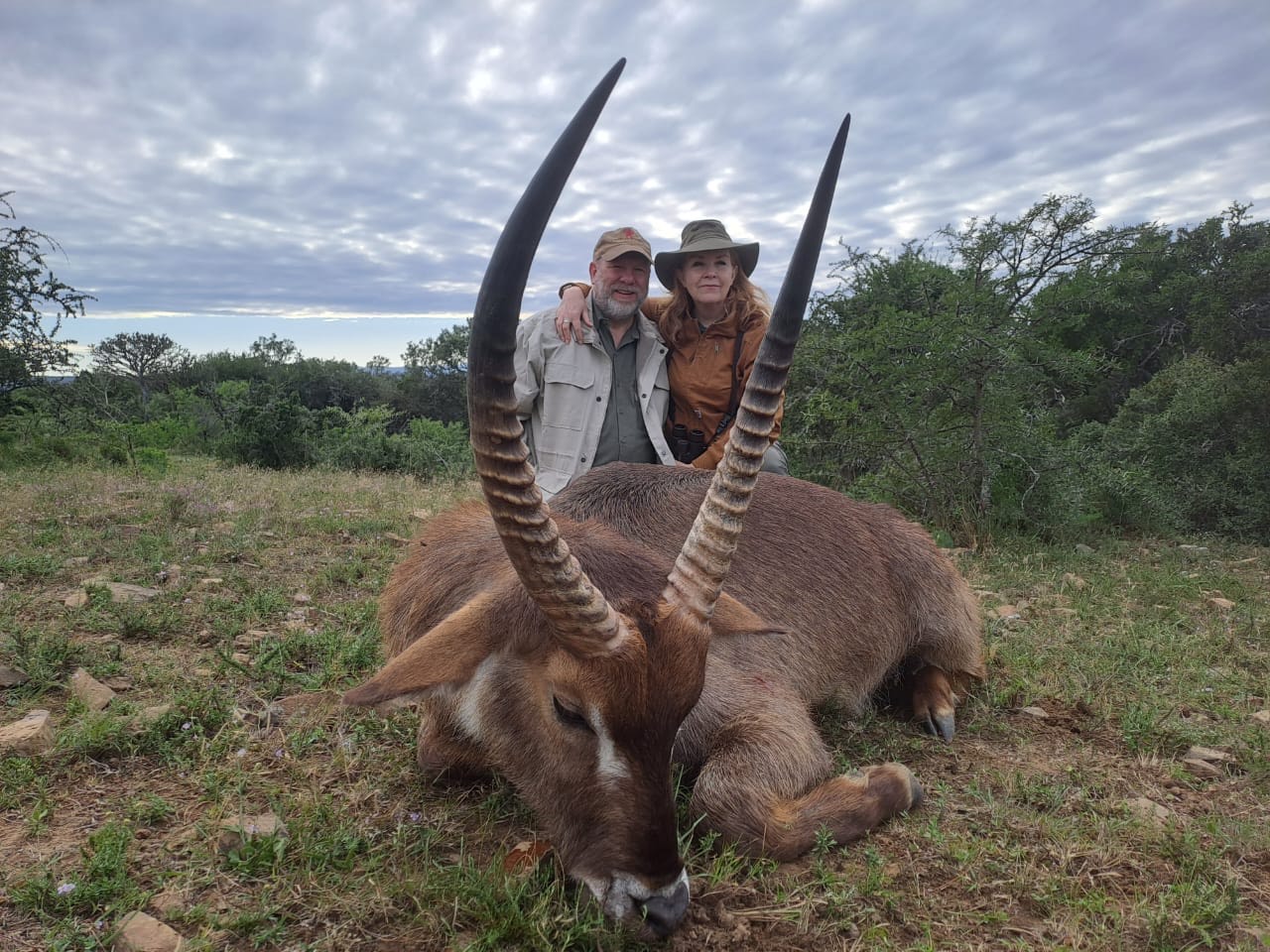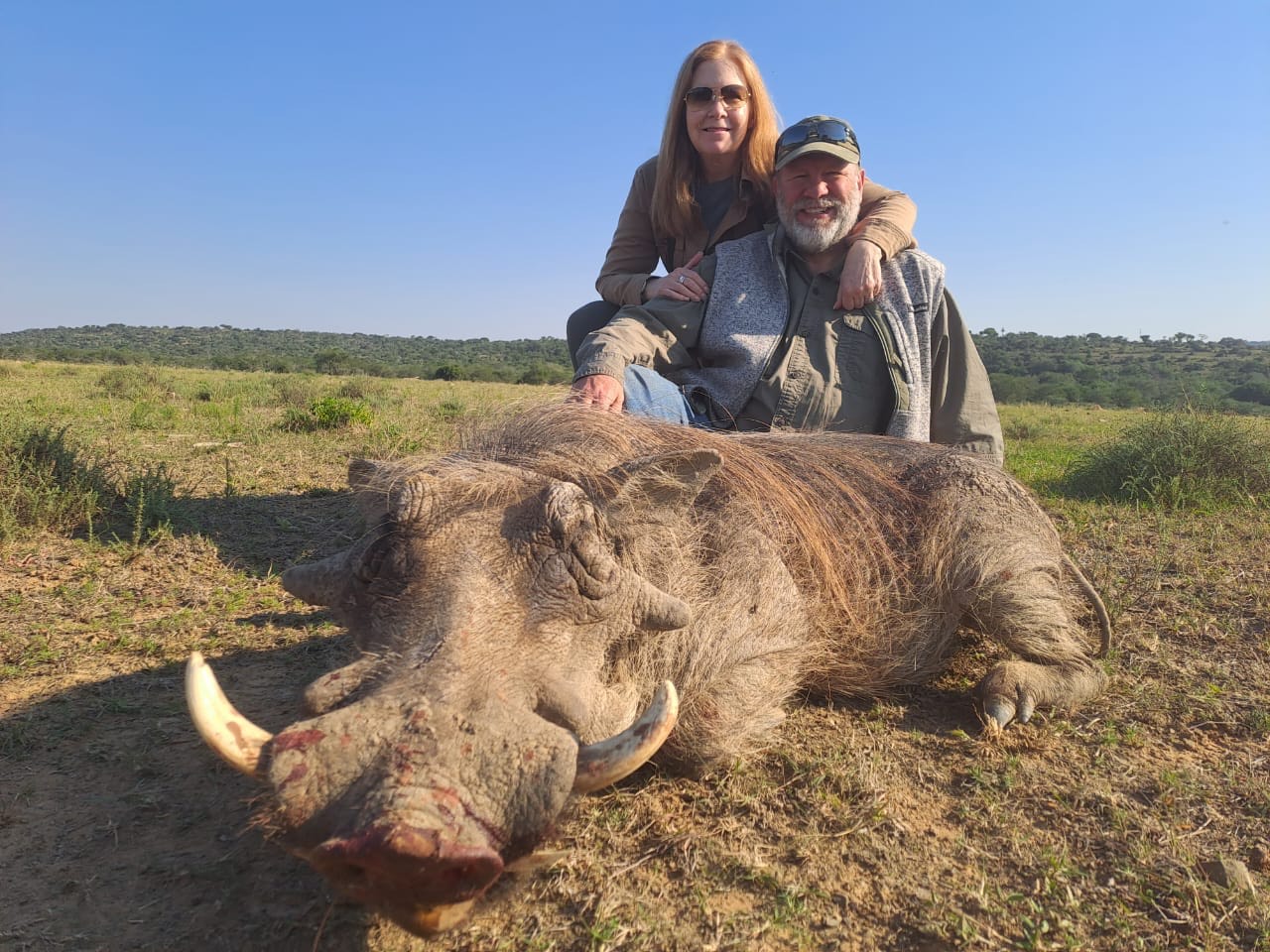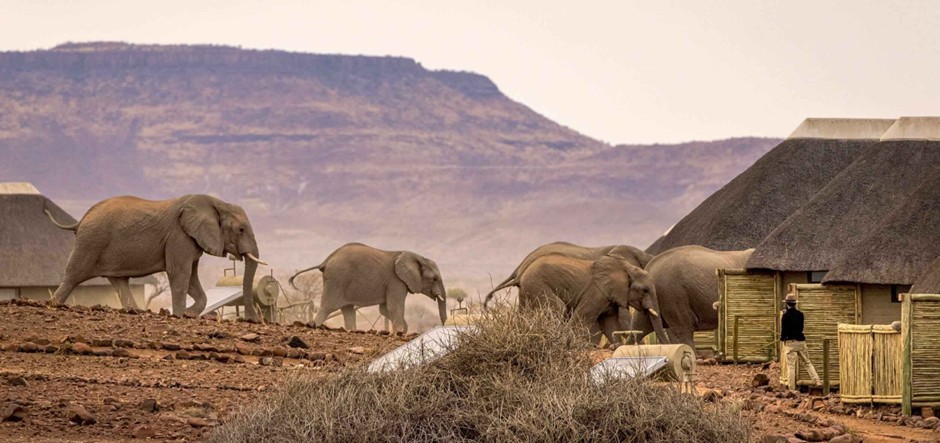By Ken Moody
An uneasy feeling tugged at my gut as we made our final approach on the wounded buffalo. We had pushed the old boy for hours and now, it seemed, the pushing was over. I knew he was there, just in the distance holed up in a tangle of sickle bush, but I also knew that he was tired and ornery and all those things a buffalo can become when they’ve decided to make a stand. As we crept closer, I also knew a decision point would be reached and that all hell was likely to come thundering towards us. I knew all of this, but onward we pressed, as this, you see, is the essence of hunting buffalo.
Bob had come to me the previous year, seeking out our booth at a trade show closest to his state of residence, hoping to discuss a possible buffalo hunt. The 13-hour drive the day before had a tiring effect, and I could see the weariness in his eyes as he sat down to talk. After an hour of discussion and attending one of my seminars, Bob booked a 10-day buffalo adventure for the following season. The actual booking of the hunt seemed to rejuvenate Bob, as after the show, he joined my wife and me for a few shots of bourbon and a perfectly cooked steak. It was a great evening spent rehashing old buffalo hunting tales and going over the finer details of his upcoming safari. When he departed our company, he was excited and determined, just the way we like our clients to be.
The year passed quickly as Bob and I kept in contact, going over his bullet selection and practice regimen. He was past 50 but in good shape and had worked on his stamina all through the off season, something evident when he walked into camp, his slimmed physique not going unnoticed. ‘Been doing some work, I see,’ I said laughing as he entered. ‘Absolutely,’ he replied. ‘Can’t let myself be shown up by you.’
Going to the rifle range proved that his health wasn’t the only thing he’d been working on. Bullet after bullet found its mark at various ranges off the shooting sticks. ‘So, you’re a sniper now,’ I quipped. ‘On paper, I’m deadly,’ he replied, laughing as he said it. ‘Let’s just hope I can keep it together on a big buff.’
The banter may have been jovial, but his words were all too true. Many clients are marksmen on the range but completely fall apart when asked to deliver a good shot on a buffalo. Some just imagine what could happen if they screw it up and pull their shots. I’ve seen them hit everywhere imaginable.
Day one of the safari began, as most do, scouting for buff. We scoured the river and other watering points for hours looking for that track that screamed, ‘come find me,’ but none were to be found. On one occasion we happened upon a small herd drinking and rolling about in the mud, a display all too common, but nothing shootable presented itself. We continued our search until darkness made the endeavor no longer viable and returned to camp for our first campfire. Much was discussed that first night. Everything from the first day’s outing – the track deciphering and the trophy quality of the bulls discovered amongst that herd we had found. Bob was excited, and rightfully so. He was in the African bush hunting buffalo and for those of us who do it, absolutely nothing could be better.
The second day of the hunt was a bit different. While we were hunting the day prior, we had one of our other team members drag all the roads in the late afternoon that paralleled the river and national park on our border. The buffalo moving out of the park and onto our concession for water would come out early, so today’s tactic was to put our tracker and PH, John, on the front of the truck and slowly drive these roads in search of good spoor. Around mid-morning we hit pay dirt. Entering our area from one of the densest parts of the park were the tracks of a small herd of old bachelor bulls, dugga boys, as we call them. The tracks were fresh and so was the dung that confirmed it. We were on to something now.
‘Your bull is at the end of these tracks, Bob,’ I said as I loaded up the double. ‘You think so?’ questioned Bob, a grin upon his sunburned face. ‘I reckon so,’ was my response. ‘I’d say these buffalo crossed here just at daylight, so we’re about four hours behind them. They’ll go to the water and linger along the river for a while as they feed. In about two hours from now, they’ll start to look for a shady place to bed, so we’ve got about that much time to close in on them.’ Bob looked a bit concerned as he replied, ‘How far is the river?’ ‘Oh, about two hours from here,’ I responded, chuckling as I said it. ‘Did you lace ‘em tight this morning?’ Bob looked down at his boots. ‘So tight I can’t feel my feet.’ We both laughed and took to the track, our PH/tracker leading the way.
The terrain sloped downhill a bit, and the initial tracking was easy, five buffalo bulls in all, making a direct line towards the river along a well-used trail. John made short work of his job, our progress steady and at a good clip. Bob showed no signs of fatigue as we finished the first mile, his work in the months before the safari evident. I knew the area well and the stroll we were on would soon become more challenging with the thickets and thorns that lay ahead. Buffalo don’t seem to mind such things, but it can become a slog for those burdened with rifles, ammo, and an accouterment of gear. I’ve always traveled light in the bush, but even so, a heavy nitro express in hand along with a belt of heavy ammunition can take a toll.
By mile two, we were into it. The gradual slope we had initially enjoyed had increased significantly as we negotiated the winding trail at a near downward angle. A gorge to our front had to be crossed and the only thing worse than getting down into it was the thought of having to climb skywards out of it. Still, we pressed on, the rewards at the end hopefully worth it. ‘How’s it, Bob?’ I asked as we finally hit the ground level at the bottom of the little canyon. ‘Good to go,’ was his positive reply.
Winding deeper into the gorge, the trail meandered along the level bottom for a few hundred yards before rising with an imposing incline to our front. We took a break before the climb, each of us drinking water and catching our breath. ‘Thought we were hunting buffalo, not mountain goats,’ Bob said. ‘Don’t be fooled by their appearance, friend,’ I replied. ‘A buffalo is pure power and can climb the steepest mountains. I’ve seen them go up hills that would make a goat envious.’ ‘Well, I’m still perfectly fine, but my rifle is worn out,’ said Bob.
We all chuckled at the remark.
Once we had rested enough, we began the ascent from the depths of the gorge along the steep trail in front of us. Huffing and puffing, one foot in front of the other, we pushed on, breaching the top and finding level ground after a 30-minute battle with fatigue. We had about 45 minutes until we hit the river.
With good walking terrain ahead of us, we made up for lost time in the gorge with a quick pace. Around noon, we entered the thickets that protected the river. The track still followed the same path, so we stuck to it, the sickle thorns tearing at our clothes and gear. When we were near to the banks of the water, John threw up his hand and the rest of us stopped instantly, bush statues barely breathing. There in the distance, standing in the shallows of the river, was a big buffalo bull, the sunlight glistening brightly from his wet boss and horns. What a brute.
With a buffalo identified, I crept up to John. ‘That’s a superb buffalo,’ I said, ‘but there’s five more around him somewhere.’ John nodded and we formulated a plan to move on the bull while hoping we wouldn’t be ‘busted’ by the others. There was a chance that this bull had stayed along the river as his mates wandered to a bedding area, but odds were, all of them were there. We just couldn’t see the others yet.
A cross wind from the water inland made our approach doable. We would circle to our left and move just outside the thicket until we came online with the buffalo, then turn into him and approach directly. We moved slowly and carefully, the sand beneath giving way with every step. At a point we judged to be across from our target, John turned us right and we crept up a slight embankment, hoping to find a vantage point from which to discern our final stalk. Cresting the little hill, we gazed upon the last known spot which held our quarry and saw nothing. The big bull had moved, to where we knew not.
‘He’s given us the slip,’ said Bob, a look of concern on his face. ‘Maybe not,’ I replied. ‘He’s likely just moved back into the thicket along with the others.’ My words to Bob were for reassurance, but I too believed that possibly the old boy had sensed our approach and moved off. Checking the wind and finding it still favorable, we crawled over the hill and towards the last known spot of our buffalo, everyone’s senses on high alert. Catching a charge in these thickets wouldn’t be conducive to our continued good health, so we all kept diligent as we moved.
As our approach brought us closer, I could hear the running waters of the mighty river and knew our proximity to the beach could be measured in mere meters. Suddenly, John held up his hand and stopped, the rest of us in limbo as he appeared to be focused on a single point to our left. John slowly motioned to come forward, and I moved a little closer as Bob tapped me on the boot, mouthing the words, ‘what’s going on,’ as I looked back. I stuck my hand out towards Bob, fingers together pointing upwards, motioning him to stop. An overanxious client who can’t hold his nerve has blown many stalks in the past and I wanted to let him know firmly to be still and keep quiet.
When I reached John in front of me, a slow-moving finger pointing at ten o’clock met me when I arrived. I pulled up my binos and cast a glance into the general direction of the finger. I concentrated on the thickets and tried to make out anything resembling a buffalo, but only saw branches and foliage. Then there it was, a movement indicating a leg. Studying the area, I could begin to see the legs of more than one buffalo, tucked away deep in that tangle. I looked at John and with a hand signal, he suggested that the buffalo were bedding down. They would shuffle a bit in the thicket but eventually all lay down and bed for the afternoon. We had gotten to the river a little too late.
I knew we couldn’t hope to be successful by trying to move towards the bedding area, so we all backed out along the trail we had entered and moved to the vantage point we had staged at earlier. ‘Why didn’t we move on them?’ Bob quipped. ‘They were only about 60 yards away.’ ‘Because you’re paying us to be smarter than you,’ I replied, smiling as I said it. ‘Moving on a group of bedded dugga boys is a recipe for failure,’ I continued. ‘Our best plan is to hold up here and wait until they get back up in a few hours. Once we determine their movement, we’ll make a plan to intercept. The wind will stay constant here along the river, so we have the advantage. This is our best course of action.’ ‘Ok, bwana,’ chuckled Bob, ‘I trust you and your team’s expertise on this.’ ‘That’ why we make the big bucks,’ I said, causing the group to laugh. Settling down on the sandbank, we had a quick lunch and rested while John kept vigil, waiting for any movement from our little group of bulls.
Around three hours into our respite, I was awakened by a pebble striking my chest. I peered under the wide brim of my hat to see John motioning us to rise and ready. The buffalo were on the move. I climbed the shallow incline and joined John and we glassed off towards the river, finding six old dugga boys strolling long its banks, moving away from our position. They were, as expected, all still together. ‘I reckon they’ll follow the river and feed along the bank,’ I whispered. ‘Let’s move parallel to them until we find terrain more suitable to an approach.’ The wind still proved favorable, and all agreed to the plan.
With Bob in tow, we crept along the brush line, just keeping out of sight of our quarry. Having given them all a good look, I surmised that at least five of the six were good bulls, any of which we’d take given the opportunity. Bob was happy with a mature buffalo and, with these additional options, I felt confident we could deliver hunter and buffalo to the same general proximity. A quick scan on my onX Hunt app showed a small hill about two hundred yards to our front along the riverbank. If we could get to it and gain a bit of elevation, we could see the bulls approaching and make a plan to intercept. A hasty ambush setup is much more productive than trying to move to a target buffalo. Having them come to you provides a great advantage in that the client can attain a dead rest position and wait for the best angle to execute the shot on an unsuspecting bull.
We picked up the pace a bit and tried to outdistance our quarry. I wasn’t concerned with the buffalo crossing the river as it was deep along this stretch and the lush grasses along the side holding them was plentiful. When I spied the hill, I motioned that we should go around and come up from behind so that we weren’t spotted during our ascent. It was a small hill just high enough to provide us with a visual advantage. We climbed the mound and once we approached the peak, got to the ground and crawled to the crest. Peering over the top, I glassed to see the oncoming buffalo, but saw nothing but a barren bank. Had I made a blunder?
‘Where they at, Chief?’ querried Bob, concerned. ‘Patience my friend,’ I responded. ‘These old bulls don’t get into a hurry.’ Outside I was calm and professional, but inside I was worried, hoping I hadn’t blown it with my ‘brilliant’ plan. A minute or so passed and then I saw it, a winged cattle egret flying over the thickets and towards the river. Following the bird, I watched as it glided effortlessly before descending and perching atop something. That something I knew to be a buffalo. ‘There!’ I exclaimed. ‘There they are.’ Bob strained his eyes, peering through his binos. ‘I don’t see them,’ he said. ‘You don’t need to,’ I replied. ‘That white bird you see there just off the bank is riding one now.’ Two of hunters’ best friends are the little oxpecker and the bright white egret. Both of these winged messengers can signal the location of buffalo as they ride them and pick off the ticks clinging to their hides.
The bird atop the bull was soon joined by others until all six buffalo had at least one egret on them. Like a beacon, we could now follow their progress and get ourselves into position. The buffalo seemed to just be mingling around a certain spot, a place I assumed where they had found some nice grass to feed on. We observed the herd for a while until eventually, one of them left the cover along the bank and ventured out along the river for a drink. Satisfying his thirst, he moved back to the others, and the wait continued. We had a little over an hour before darkness set in, so if they didn’t move soon, we’d have to go in and take our chances.
‘I think we need a new plan,’ whispered Bob, his lack of patience getting the better of him. ‘We already have one,’ I said. ‘We’ll move from here and go to them if they don’t head this way soon.’ Smiling, Bob gave me a thumbs up as we went back to the binos. The problem with moving on them now was the ‘scouts’ sitting on their backs. The egrets would most likely spot us and take flight, alerting the herd to our presence, but soon, a decision would need to be made. Another 15 minutes passed. ‘Ok, let’s go.’ I had concluded that the old group of bachelors had become very content with the patch of grass they’d found and were in no hurry to leave it. If we didn’t make our move now, darkness would catch us, and the day would be lost. It was now or never.
I gathered the group and, collectively, we made a plan of action. We’d sneak off the side of the hill and follow it around to the riverbank where we’d approach from the water’s side towards the clump holding the buffalo. It would be much quieter to creep along the sand than through the tangle of thickets. We’d use the birds as reference and if we were lucky, they’d be more interested in eating ticks than staying alert. We had to move slowly, but in a hurry. Any experienced buffalo hunter knows exactly what that means. Like snakes, we crept along that riverbank, inching our way closer to a hopeful paydirt. Staying low, we ensured that we were beneath the birds’ line of sight while occasionally raising up a bit and reestablishing their position. Time was not on our side, so we moved cautiously, but with purpose. John led us forward, searching for just the right spot from which we could wheel inward and towards our prey.
A slightly raised hand from our tracker signaled a stop. As he pointed to his ear, I strained to hear the tell-tale sounds of a buffalo herd feeding, the grass being munched just faintly audible. Then a grunt came from the thicket, followed by another. The buffalo were fully engaged in feeding and the wind was perfect. During our hunt briefing, which occurred the day Bob got to camp, we went over this type of scenario; where he was to be in line, what hand and arm signals meant, where to shoot based on the buffalo’s presentation, all of it. There’s no time in the field to address these things, it must be understood prior to the hunt. When signaled, we all turned into the thicket and began the tedious move, all of us on hands and knees. The closer we crept, the louder the feeding sounds became. I tapped Bob on the foot as we moved and smiled at him, hoping to calm the anxiety I knew was there. It’s a big moment when closing in on a massive Cape Buffalo. All the things that could go wrong and all the power they could bring to bear can be overwhelming to think about. It takes a lot of experience to quell those thoughts and focus on the job at hand. Just move into position and get it done. That’s all you should concentrate on.
As we crept closer, a trail appeared that seemed to go on a direct line to the buffalo. Maybe this was a spot they knew well and used frequently enough to carve out a decent line of approach as they had moved back and forth to the river. For whatever reason, I was happy we’d found it, as it would be much easier to negotiate than picking our way through the tangles. We took the trail and closed the distance, the sounds of the buffalo now amplified by our close proximity. Rounding a turn on the trail, John froze, causing us all to stop dead on the trail. The seconds seemed like forever as we lingered there, motionless and barely breathing. I could see Bob kneading the sand with his right hand as his nerves were to the breaking point. Suddenly, all was quiet. The feeding sounds, the movement, all of it ceased. They knew we were there.
A single grunt emitted from one of the bulls signaled the stampede as all six of the dugga boys came thundering down the very trail which held our party. Having little time to react, John rolled from the trail into the thicket as Bob and I rose up to our knees, rifle barrels in tow. BOOM went the shot from Bob’s .416, the bullet seeming to strike the first buffalo in the chest, merely paces to our front. BOOM came a second shot, my .470 responding to Bob’s initial round. The stricken bull turned, crashing through the thicket not an arm’s length in front of us while the rest of the herd scattered behind him, the sand and dirt thrown into the air causing a cloud of unbreathable debris. Chaos is the only description.
Seconds passed and I could hear the crashing of water as one or more of the buffalo made their way across the river. Was our wounded bull amongst them? I quickly checked on Bob and ensured his rifle was made safe before moving up to check on our valiant PH and tracker, John. ‘How’s it, John?’ I queried as the old African got to his feet. ‘Close,’ he replied, brushing the sand and dirt from off his clothes and pulling the branches of thorns away. John shook his head and checked his old bolt action .458 as all three of us took a few moments in silence to try and pull ourselves together. I knew that had the impact of our bullets not turned the buffalo, both Bob and I would be dead or seriously injured, knowledge that was not lost on Bob. ‘Do you think he’s down?’ Bob asked, a concerned look blanketing his face. ‘Doubtful,’ I replied. ‘A buffalo is a bullet sponge, and my shot was somewhere in the black, that’s all I can say. It happened too fast for any accurate shooting, and I basically pulled once the butt of the gun hit my shoulder.’ ‘Me too,’ sighed Bob. ‘I think I might have actually shot from the hip.’ Bob’s demeanor had, understandably, changed dramatically. I could see the fear engulfing him having just survived the shock of a buffalo charge and I knew that now, getting him onto this buffalo would be difficult. I, too, was shaken as anyone would be. All the bravado and hubris in the world can’t save you when it’s your time. Fortunately, it wasn’t ours.
I had no reason to believe that bull was down from those two ‘Hail Mary’ shots, but at that range, maybe one or both of us hit something good and we would find him on the other sides of the water. Once composure was reestablished, we moved onto the track, which took us straight to the river’s edge. There, we found the spoor of all six buffalo entering the water and we could spy that they’d exited the other side, directly across from us. The water was too deep for a crossing and with crocodiles ever present, we chose to find a more accommodating fording place for tomorrow’s track. With the darkness approaching, we marked the spot and began the long, slow trek back to our truck and then to camp. Once there, we showered and got to the fire started for a nice, filling supper of loin and vegetables.
Bob was still visibly shaken. His anxiousness had been replaced with doubt and his positive attitude with fear. He was no longer the Bob we had started with. ‘Chin up, Bob,’ I said firmly. ‘We are obligated to sort this thing out and must finish the fight. I fear we may be in for a long one tomorrow, so let’s get to bed early and rest up. I know today was not what you expected, but every buffalo hunt is different and occasionally, we get a charge. You did well not freezing up, and at least got a bullet into him. Without your shot, the day may have ended differently.’ ‘Well,’ said Bob, ‘I’m certainly no hero. I can’t even remember pulling the trigger. I don’t know what I’ll be able to do tomorrow,’ he lamented. ‘I’m sure you’ll do your job, Bob. John and I will be there and when the time comes, we’ll all flatten that buffalo if he’s still on his feet.’ After a couple of bourbons, we retired for the evening and awaited the morning’s arrival.
The ride to the river was a quiet one, all of us feeling a bit of anxiety over what may be waiting for us once we crossed the water. Bob seemed a bit melancholy and John, as usual, was steadfast. I was feeling confident and figured with two bullets in him, our bull might be a bit sluggish and hold his ground rather than run away, a benefit to us once we caught up to him. His five companions, however, gave me reason for pause. They would be a different story and hopefully, not need too much convincing to leave their wounded comrade when the time for unleashing lead was at hand. John knew the area well, so upon reaching the river, he found a nice fording spot and drove us across, the water lapping over the running boards on the side of our cruiser. We exited the truck just as the first rays of sunshine filtered over the hills and onto the riverbank. It was time to go.
A brisk, chilly wind nipped at my exposed face once we sorted the track and began moving into the thickets. I was cold but knew the rising sun would bring with it the warm rays of comfort before eventually turning the temperature up to the high 30s (Celsius). With rifles loaded and mentally prepared, we pushed forward, the tracks of six fleeing buffalo easy to follow in the sandy terrain. When we broke out of the thickets, the separation between the buffalo increased, so John was careful to ensure we followed our wounded bull. Meticulously, he surveyed the ground and went along each track until the slightest trace of blood revealed itself. With a light whistle, he pointed towards the ground, and we were off, the wounded bull heading on a straight line into the bush.
The blood was sparse, but the track remained solid, all the bull’s spoor becoming intermingled from time to time before opening up again. John had our bull’s track in his head so he could easily distinguish it from the others, making the tracking move at a nice pace. Every so often we’d find a patch of blood indicating that the buffalo had lingered there momentarily before moving off. The track had started as a running spoor but now was a steady walk, the wind still in our favor. ‘What do you think?’ whispered Bob. ‘I think we’ll catch up to him before midday, but he’s not going down anytime soon. We’ll need to convince him to surrender,’ I replied, trying to inject a bit of levity into a tense situation. ‘Are you ready for that?’ I asked. ‘Let’s hope,’ said Bob, still feeling a bit dejected by the entire scenario.
Around 10:30am, the wind began to get ‘squirrely’ as it normally does that time of morning. Back and forth, one side to the other it swirled. I knew we’d be winded once we got close to the herd, but we had no choice, we had to follow where our wounded bull led. An hour or so later we all heard it, the buffalo crashing to our front and right, branches breaking with a dust cloud rising through the thicket. Busted! We all stood motionless as the sounds of running buffalo dissipated in the distance. ‘Was he with them?’ I pondered, staring at the thicket which had, seconds earlier, held the herd. John and I conferred and both of us had the suspicion that possibly our buff was still there within the confines of thorns before us. ‘Let’s proceed with caution,’ I whispered. ‘I have a feeling he’s still in there,’ I continued while looking at Bob. As quietly as we could, we moved slowly towards the clump ahead. An uneasy feeling tugged at my gut as we made our final approach. Just before we entered the thicket, I placed my hand on Bob’s shoulder just to remind him I was there and to also direct him if needed. Into the dimming light we went, John in front, Bob and I on his heels. There wouldn’t be much room to maneuver in the tangles, and I was happy to be carrying a double rifle as there would be little time for working a bolt action at the distance we might find ourselves at.
On we went, slinking down into a small ravine, until we found the tracks of the herd. Here we followed, but just before we broke out into the open again, an audible grunt broke the silence and a mass of black stormed from the cover of a thornbush towards us. Bob raised his rifle and froze, standing motionless as my rifle came to shoulder. BOOM went John’s .458 staggering the bull, which shook his head but plowed ahead. BOOM, BOOM came my report, both barrels unleashed at under 10 yards, but still he came, momentum undeterred. I reached over and grabbed Bob, who still hadn’t moved, and pulled him towards me, diving onto the bank of the little ravine.
The bull passed us, flicking his massive horns to the left and catching Bob on his shoulder. Turning, the bull charged back but was met with a volley from John’s Bruno and one of my barrels which had been hastily reloaded. The buffalo staggered but didn’t fall, turning again and escaping on the trail we’d entered on. Bob grasped his shoulder, which seemed bruised but was not bleeding. ‘Are you ok?’ I asked, obviously concerned that our client might be injured. ‘I think so,’ he replied. ‘My arm is sore, but he didn’t hit me too hard, just grazed me as he ran by.’ ‘Can you function?’ I continued. ‘Maybe, but I’m not too sure I want any more of this. It’s just not what I thought it would be.’ ‘I noticed you were having trouble getting a shot off,’ I said, hoping he could explain his lack of participation. ‘I don’t know,’ Bob said, shaking his head. ‘Just couldn’t seem to move or do anything. I don’t know.’
I knew that this buffalo had to be taken down and knew it would be John and myself who did it. Bob was a liability at this stage and frankly, scared shitless. His proximity to John and me with a loaded rifle was far scarier than facing the wounded buffalo. A few professionals have been shot by frightened clients, some killed. Likely all of us have been shot at, me twice in desperate situations. ‘Bob, as much I’d like to have you finish the job we’ve started, I fear you might cause us some anxiety now when we close in on this buffalo again. If you’re not 100% up to it, I’d suggest you remain here in the ravine up on the side of the bank where it’s relatively safe while John and I go forward and sort this out. It’s up to you.’ ‘Go for it,’ he said. ‘I’ll feel much better about it if I’m not there.’ With those words, John and I turned and got to the track, the wounded bull surely close by.
John and moved with purpose, both of us knowing a reckoning was about to occur. This buffalo couldn’t absorb that much punishment and be too far from us. At least we hoped we’d find him quickly.
When we got back to where we’d entered the ravine, we saw him, an old warrior with worn horns and shiny, smooth bosses, staggering as he stood, seeming to dare us into coming closer. He wanted to go down but wouldn’t. He just stood there, blood oozing from his mouth and wounds, head slumping, defiant to the end. I whispered to John to go get Bob and bring him up, as we were only a hundred yards or less from the old bull. Bob needed to administer the coup. I stood there watching the buffalo, my grip on the rifle tight, ready to end it if necessary. In minutes, John returned to us, Bob in tow. I brought Bob up by my side and once John had set up the shooting sticks and Bob’s rifle was cradled within them, I looked at my client and simply said, ‘finish him.’ The .416 cracked once and the old bull buckled. A second shot put him on the ground, and one more ended it. We had done it. As we closed on the downed buffalo, John looked at me an uttered one word… ‘Bulletproof.’ ‘Almost,’ I replied, ‘almost.’
